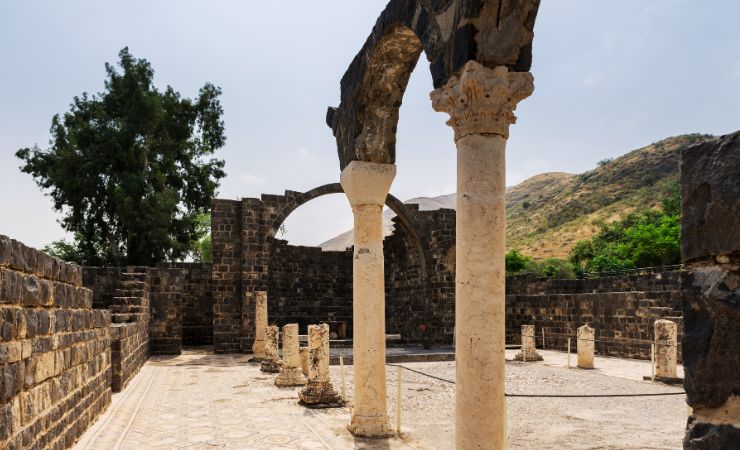Kursi: The Miracle of the Swine Unveiled
At Kursi, Jesus’ “Miracle of the Swine,” occurred. This event narrated in the New Testament, makes it a significant point of interest for both history enthusiasts and spiritual seekers. Its name, meaning “chair” in Semitic languages, likely refers to the shape of the broad valley behind it.

Location
Kursi is situated near the eastern shore of the Sea of Galilee, along the bank of a wadi, Nahal Samakh, descending from the Golan Heights.
Biblical context of Kursi
Kursi holds a special place in the New Testament, specifically in the Gospel of Mark (5:1-20) and Luke (8:26-39). It is traditionally believed to be the site where Jesus performed the Miracle of the Swine. In this miracle, Jesus exorcised a man possessed by demons, which then entered a herd of pigs that subsequently plunged into the lake.
This event is a significant moment in Jesus’ ministry, demonstrating his authority over evil spirits and his compassion for those suffering.



Kursi's archeological history
A Site Revered by Early Christians
Early Christian writers and pilgrims, including St. Sabas, the founder of the Mar Saba monastery, recognized Kursi as the site of the miracle. St. Sabas himself is known to have prayed at the site in 491 CE.
Rediscovery of Kursi
For many centuries, Kursi lay forgotten until a chance event in 1970 led to its rediscovery. As a bulldozer was constructing a new road to the Golan Heights, it unearthed pieces of Byzantine pottery, hinting at the historical treasure that lay beneath. Excavations at the site revealed not only a monastery complex but also an ancient fishing harbor, complete with a breakwater and a pool for storing live fish awaiting sale.
Unveiling the Monastic Life
The monastery at Kursi, built in the 5th century, was an extensive complex covering 18,000sqm. It was surrounded by a defensive stone wall and featured a watchtower. At the heart of the complex was a large church, fronted by a spacious courtyard. The church was divided into a nave and two side aisles by two rows of stone columns. A chapel in the right-hand aisle housed a crypt where the skeletons of 30 monks were found.
The monastery also housed an oil press, suggesting that olive oil production was a significant source of income for the monks. Living quarters for the monks, a guesthouse, and a bath complex for pilgrims were also discovered. A paved road connected the monastery to the harbor, where pilgrims arrived.
The church floor was adorned with mosaics depicting various forms of life, including roosters, geese, doves, cormorants, fish, and an array of fruits. However, when the monastery was abandoned in the early 8th century, all animal mosaics were obliterated to comply with Islamic prohibitions against human or animal representations.
A Chapel with a View
A chapel built on the hill behind the monastery likely predates the monastery itself, as its mosaic floor includes crosses, which were prohibited on church floors from the year 427 CE by order of Christian emperor Theodosius II. A stone bench in the chapel offered a view of the boulder believed to mark the site of the miracle, and beyond it, the Sea of Galilee.
Archeological finding
- Byzantine Monastery: The remains of one of the largest Byzantine monasteries in Israel were discovered here. The complex includes a chapel, dining room, and accommodations for monks.
- Mosaic Floors: The monastery’s church boasts intricate mosaic floors, depicting animals, birds, and geometric designs, reflecting the high artistic level of the period.
- Inscribed Stone: An Aramaic inscription mentioning the “monastery of the holy martyr” was found, providing evidence of early Christian worship at the site.
- Marble Plaque: A marble plaque with a Greek inscription was discovered, indicating the site’s identification with the Miracle of the Swine.
Sources and Additional Reading
Kursi, Sea of Galilee – Wikipedia
Kursi – See The Holy Land
The synagogue inscription at Kursi
Nearby sites
- Church of Beatitudes: This church on a hilltop site is traditionally believed to be where Jesus delivered the Sermon on the Mount, offering panoramic views of the Sea of Galilee.
- Corazim: An ancient village, it was one of the cities condemned by Jesus for its lack of faith
- Capernaum: Known as Jesus’ “own city”, it’s home to a modern church built over St. Peter’s house and an ancient synagogue.
- Bethsaida: An ancient city on the north shore of the Sea of Galilee, mentioned several times in the New Testament.



